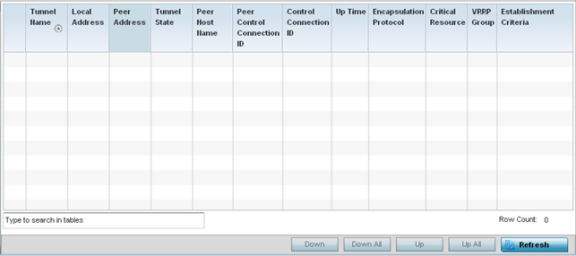AP L2TPv3 Tunnels
Access points use L2TP V3 to create tunnels for transporting layer 2 frames. L2TP V3 enables an access point to create tunnels for transporting Ethernet frames to and from bridge VLANs and physical ports. L2TP V3 tunnels can be defined between WiNG devices and other vendor devices supporting the L2TP V3 protocol.
To review a selected access point's L2TPv3 statistics:
- Select the Statistics menu from the Web UI.
- Expand the System node from the navigation pane (on the left-hand side of the screen). The System node expands to display the RF Domains created within the managed network.
- Expand an RF Domain node, select a controller or service platform, and select one of its connected access points. The access point's statistics menu displays in the right-hand side of the screen, with the Health tab selected by default.
- Select L2TPv3 Tunnels from the
menu.The screen is displayed.
 This screen displays the following:
This screen displays the following:Tunnel Name Displays the name of each listed L2TPv3 tunnel assigned upon creation. Each listed tunnel name can be selected as a link to display session data specific to that tunnel. The Sessions screen displays cookie size information as well as psuedowire information specific to the selected tunnel. Data is also available to define whether the tunnel is a trunk session and whether tagged VLANs are used. The number of transmitted, received and dropped packets also display to provide a throughput assessment of the tunnel connection. Each listed session name can also be selected as a link to display VLAN information specific to that session. The VLAN Details screen lists those VLANs used an access point interface in L2TP tunnel establishment.
Local Address Lists the IP address assigned as the local tunnel end point address, not the tunnel interface's IP address. This IP is used as the tunnel source IP address. If a local address is not specified, the source IP address is chosen automatically based on the tunnel peer IP address.
Peer Address Lists the IP address of the L2TP tunnel peer establishing the tunnel connection.
Tunnel State States whether the tunnel is Idle (not utilized by peers) or is currently active.
Peer Host Name Lists the assigned peer hostname used as matching criteria in the tunnel establishment process.
Peer Control Connection ID Displays the numeric identifier for the tunnel session. This is the peer pseudowire ID for the session. This source and destination IDs are exchanged in session establishment messages with the L2TP peer.
Control Connection ID Displays the router ID(s) sent in tunnel establishment messages with a potential peer device.
Up Time Lists the amount of time the L2TP connection has remained established amongst peers sharing the L2TPv3 tunnel connection. The Up Time is displayed in a Days: Hours: Minutes: Seconds: format. If D:0 H:0 M:0 S:0 is displayed, the tunnel connection is not currently established.
Encapsulation Protocol Displays either IP or UDP as the peer encapsulation protocol. The default setting is IP. UDP uses a simple transmission model without implicit handshakes. Tunneling is also called encapsulation. Tunneling works by encapsulating a network protocol within packets carried by the second network.
Critical Resource Lists critical resources for this tunnel. Critical resources are device IP addresses on the network (gateways, routers etc.). These IP addresses are critical to the health of the network. These device addresses are pinged regularly by access points. If there‘s a connectivity issue, an event is generated stating a critical resource is unavailable.
VRRP Group Lists a VRRP group ID (if utilized). A VRRP group is only enabled when the establishment criteria is set to vrrp-master. A VRRP master responds to ARP requests, forwards packets with a destination link MAC layer address equal to the virtual router MAC layer address, rejects packets addressed to the IP associated with the virtual router and accepts packets addressed to the IP associated with the virtual router.
Establishment Criteria Displays the tunnel establishment criteria for this tunnel. Tunnel establishment involves exchanging 3 message types (SCCRQ, SCCRP and SCCN) with the peer. Tunnel IDs and capabilities are exchanged during the tunnel establishment with the host.
- Select Refresh to update the screen's statistics counters to their latest value.

